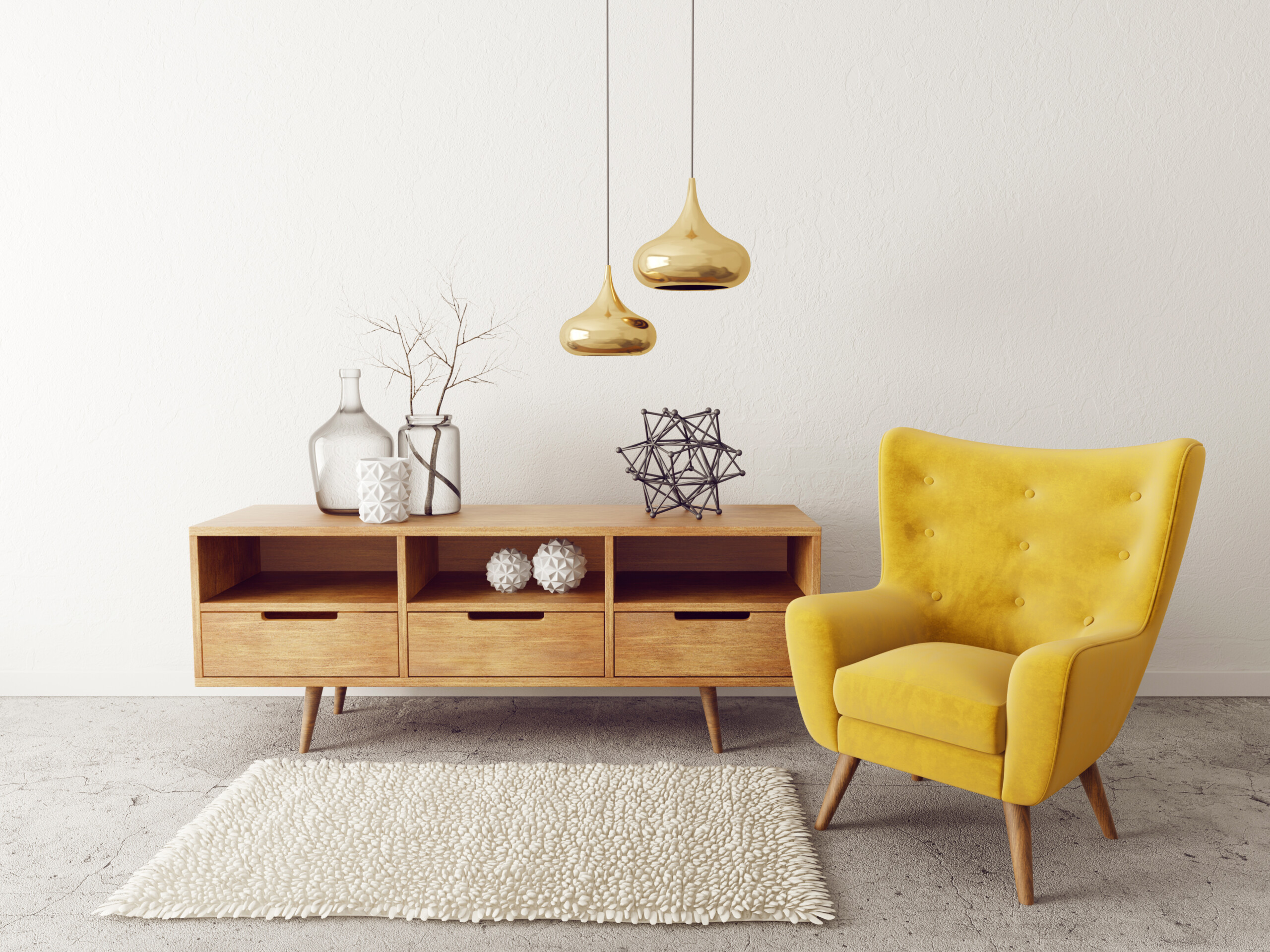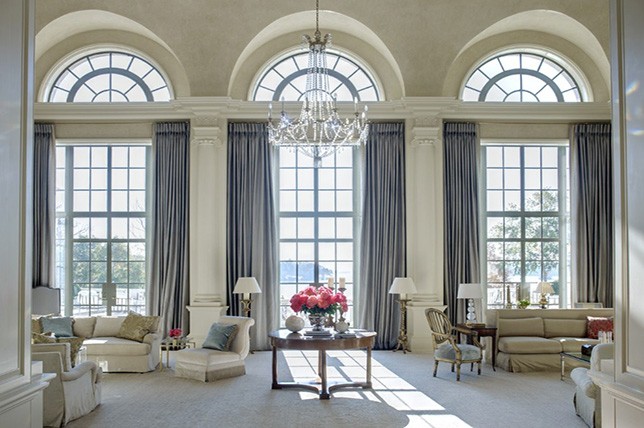
With the profession of interior design clocking in at just over 100 years old, we’re looking at the roots of interior design history and the seven legendary decorators who made a name for themselves as the industry started gaining momentum in the early 1900’s. From the Ancient Egyptians to the dawn of modern interior design, here’s everything you need to know.
It may seem a bit elementary, but let’s start with the basics of interior design services. Interior design is defined as the art and science of enhancing the interior of a space in order to create a polished and more aesthetically pleasing environment. An interior designer is someone trained to execute plans, research, coordinate, and manage decorative projects with authority. The profession of interior design is varied and includes space planning, conceptual development, site inspections, programming, research, communicating with the clients, project and construction management, and of course the execution of the desired design.
Before the profession rose to prominence, interior design came in instinctively to strictly coordinate with the architecture of buildings. The profession of interior design came with the rise of middle-class society and the complicated architecture that rose to popularity during the industrial revolution. The quest to make the best use of space, along with the attention to user well-being and functional design continues to push the development and life-enhancing possibilities of today’s iteration on the interior design profession. That said, the profession of interior design is distinctly separate from the work of an interior decorator, a moniker more commonly used across the US. The term interior decorator is less commonly used in the UK where the profession of interior design remains unregulated and sadly, not yet considered an official profession to this day.
As far back as ancient India, architects used to double as interior designers to fully develop their complete vision. This can be noted from the references of architect Vishwakarma – one of the gods featured in Indian mythology. Those references feature sculptures illustrating ancient texts and events seen in palaces constructed in 17th-century India.
Throughout ancient Egypt, “soul houses” or models of houses were gifted in tombs as vessels for food offerings. From these evocative trinkets, it’s possible to decipher cues about the interior design of various residences throughout several Egyptian dynasties, including updates to ventilation, porticoes, columns, loggias, windows, and doors.
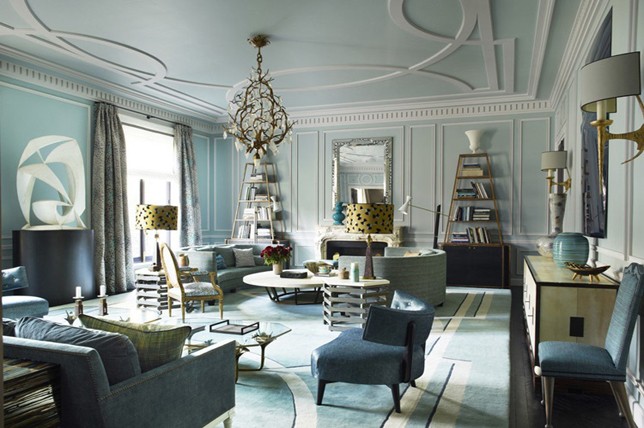
Throughout the 17th and 18th centuries and into the first part of the 19th century, interior decorating was an exclusive concern relegated to the homemaker, or a professional upholsterer or craftsman who could securely advise based on their artistic eye for a home’s interior design. Incidentally, architects would also turn to craftsmen and artisans to create interior design for their buildings.
The practice of interior design harkens back to the Ancient Egyptians, who decorated their naive mud homes with basic furnishings enhanced by animal skins, simple textiles, graphic biographical and spiritual murals, sculptures, and painted urns. Ornate gold ornaments found in Egyptian tombs (such as King Tutankhamen’s) and trinkets highlighted the need for more distinctively rich decoration to symbolize the more wealthier and powerful Egyptians.
Roman and Greek civilizations advanced the Egyptian art of interior designing and accessorizing by celebrating civic pride through their invention of domed-roof public buildings. For their homes, elaborate Greek wooden furniture featured intricate ivory and silver decoration while the Romans concentrated on marrying beauty and comfort, with both civilizations home interiors designed to reflect wealth and social and political status. Roman furniture was often made of stone, marble, wood, or bronze, and was made comfortable via cushions and expressive tapestries. To elevate their homes, both Romans and Greeks brought in vases and created mesmerizing mosaic floors, and wall paintings and frescoes to make their spaces unique to them.
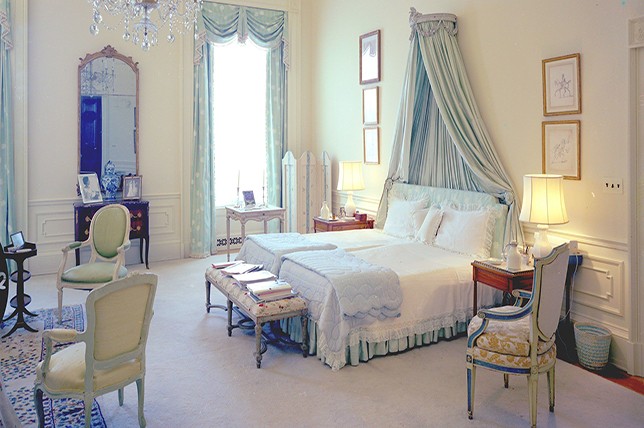
Following this period of decorative ornamentation, there was a sudden movement to exactness due to the grim ongoing wars throughout Medieval Europe and the rise of the Christian church. Coined The Dark Ages for good reason, interior design history of the era featured somber wood paneling, minimal and solely practical furnishings, and stone-slab flooring. Even wealthier patrons of the era stuck to muted, sobering colors when adding decorative extras like tapestries and stonework.
After The Dark Ages, Europeans were once again inspired to introduce color and decorative ornamentation into their homes. During the 12th century, darkly romantic Gothic style was created to make the best use of natural light and freshly popular open interiors.
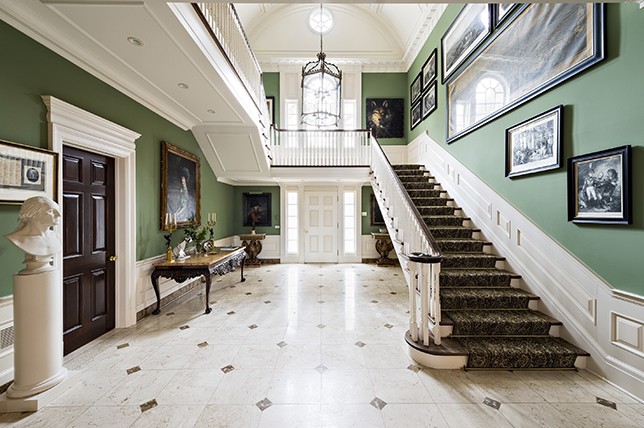
Throughout the 15th and 16th centuries, the French Renaissance started a renewed focus on art and creativity in interior design. Architects of the time began creating homes with substantial decorative notes including marble floors, ornate inlaid woodwork, paintings, and furniture made with the finest materials. A quick look at the eras royal palaces, villas, and chapels is certain to highlight the best of Renaissance interior design.
Following the Renaissance, intricate and complex Italian Baroque designs took a hold over Europe. The Palace of Versailles in France for instance made remarkable use of Baroque interior design elements like colored marble and stone, stained glass, ornately painted ceilings, and spiraling columns. By the 18th century, European interior designers made Rococo style increasingly popular while taking influence from Asian stoneware, floral prints, and furniture inlaid with exotic details like ivory and mother-of-pearl. Then came the Neoclassical look of the late 18th century, a distant take on the celebrated design elements found in ancient Rome with its use of brilliantly colored silk, satin, and velvet.
From the early 1800’s and on, more freedom and eclecticism was often found in interior design in Europe and America. And over the next two centuries, a slew of innovative and modern interior design movements would come and go out of style as the times changed including Art Deco, Art Nouveau, Victorian, and industrial Bauhaus style. The 19th century saw, however, the ultimate in appreciation and the popularization of interior design. No longer exclusive to royal compounds and homes of wealthy citizens, the possibilities of life-enhancing interior design began to reach critical masses in the later part of the 1800’s.
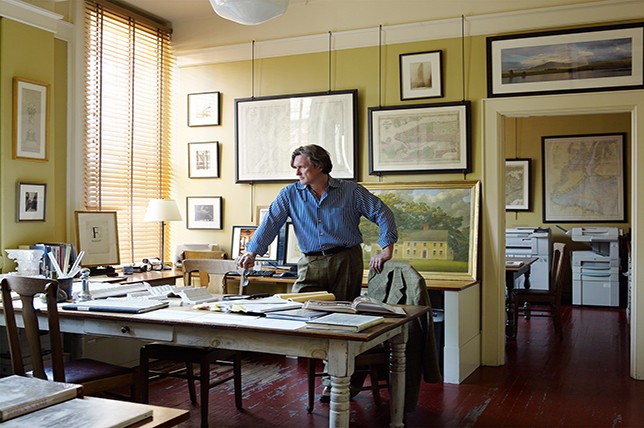
And by the 20th century, functionality became a key component in the approach to interior design as the growing presence of home appliances such as stoves, washing machines, and televisions prompted a new challenge for interior designers, who had to design spaces with more than aesthetic reasons in mind.
And as the 20th century turned, novice designers and numerous publications were increasingly working to defeat the hold that large upscale retail outlets had on the world of interior design. Before that, feminist English author Mary Haweis produced a series of popular essays in the 1880’s where she ridiculed the excitement of an aspiring class of bourgeoise people looking to furnish their homes hastily around the strict yet bland confines offered to them by dictating retail outlets. Her response was that people should seize the opportunity in creating a particular take on a design style uniquely tailored to address their needs and lifestyles. “One of my strongest convictions, and one of the first canons of good taste, is that our houses, like the fish’s shell and the bird’s nest, ought to represent our individual taste and habits,” she wrote.
The slow transition towards the decorative arts being seen as an individual artistic profession aside from the salesman’s wisdom offered by manufacturers and retailers was boosted in 1899 with the launch of the Institute of British Decorators; with John Dibblee Crace acting as its president. The institute represented over 200 interior designers around the nation. And by 1915 the London Directory saw an increased listing of 127 individuals working as professional interior decorators, of which only 10 were women. Rhoda and Agnes Garrett were the first recorded women to be coached professionally as home designers in 1874. The importance of their design work was considered at the time to be parallel with the legendary interior maestro William Morris. In 1876, their guide – Suggestions for House Decoration in Painting, Woodwork and Furniture – further cemented their authority and spread their takes on artistic interior design approaches to a design hungry middle-class.
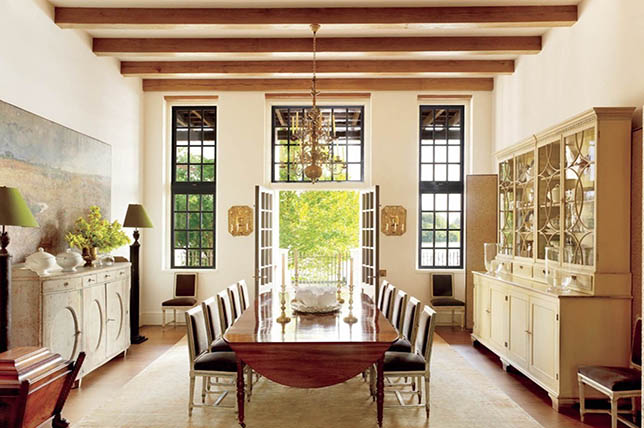
“Until recently when a man wanted to furnish he would visit all the dealers and select piece by piece of furniture ….Today he sends for a dealer in art furnishings and fittings who surveys all the rooms in the house and he brings his artistic mind to bear on the subject,” as The Illustrated Carpenter and Builder wrote in 1900.
Back in America, Candace Wheeler, considered one of the first female interior designers, encouraged a completely new take on American interior design. She was a key figure in developing the first interior design courses for women in a number of major American hubs and was celebrated as the definitive authority on home décor at the time. Another prominent influence on the newly categorized profession of décor was The Decoration of Houses, a widely read and consulted guide on interior design written by Edith Wharton and master architect Ogden Codman in 1897 stateside. In the popular book, the authors deemed Victorian-style interior décor and interior design irrelevant. No longer viable were the cold, dark, and moody homes decorated with heavy furnishings, Victorian accessories and tufted, overstuffed seating. They considered the design style having put too much importance on upholstered furnishings instead of sensible space planning and architectural details, making rooms dreary, uncomfortable, untouchable and therefor all too precious. Their book is still regarded as a seminal moment and their success propelled the rise of professional interior designers adopting similar stances.
As you can see, the world of interior design has come a remarkable way since the Ancient Egyptians as designers today have unlimited access to an endless amount of design movements, furniture styles, and influences from the past. But it’s really the seven interior designers we’re focusing on here that truly changed the way we approach interior design for the better.
INTERIOR DESIGN HISTORY TIMELINE:
Stone Age 6000 to 2000 BC
The first sign of an approach to interior design was noted in prehistoric dwellings featuring flora and fauna. Those dwellings were made of mud, animal skins, and sticks.
Neolithic Europe 2000 to 1700 BC
In comes the first defined handmade pottery that was used for both practical and decorative reasons.
Ancient Egypt 2700
The rise of royal families saw for the first time people living in structures besides mud huts. The new structures boasted murals that portrayed their history and beliefs. And they had basic furnishings and decorative objects like vases and sculptures – seen for the first time.
Greek Empire 1200 to 31 BC
Advancements in civilization and lifestyles saw citizens decorating their homes in their own unique style for the first time ever with wealthier Greeks possessing furnishings inlaid with ornate ivory and silver details. Iconic and statement-making pillars and columns were key motifs during this era and the Greeks also created standard rules and procedures for building construction.
Roman Empire 753 BC to 480 AD
An austere age when royals weren’t able to evoke their wealth simply through their homes. The Romans decorated their homes with murals and mosaics, and furnishings featured clawed feet.
The Dark Ages 900 to 1500
The Dark Ages saw disinterest in interior design with people opting for simple paneled wood walls, minimal furnishings, and stone slab floors.
The Byzantine Empire 500 to 1500
During this period grande domes and decadent décor took center stage.
The Renaissance Period 1400 to 1600
The beauty of interior design was a major feature during the Renaissance period with grand furnishings and art realized in vibrant hues and luxurious textiles like silk and velvet along with marble surfaces. And since carpets were too precious and expensive for even the wealthiest of patrons, they were used as wall art when possible.
Gothic 1140 to 1400
In response to the dark ages, decorative ornamentation and bold colors were once again prominent interior design features. Two hallmarks of the era carried over through to today are more windows for brighter homes along with open floor plans.
Baroque 1590 to 1725
Ostentatious and ultra-rich artistic elements made for a recipe of sumptuous interior designs featuring stained glass, twisted columns, colored marble, painted ceilings, and gilt mirrors and oversized chandeliers.
Traditional 1700 to Today
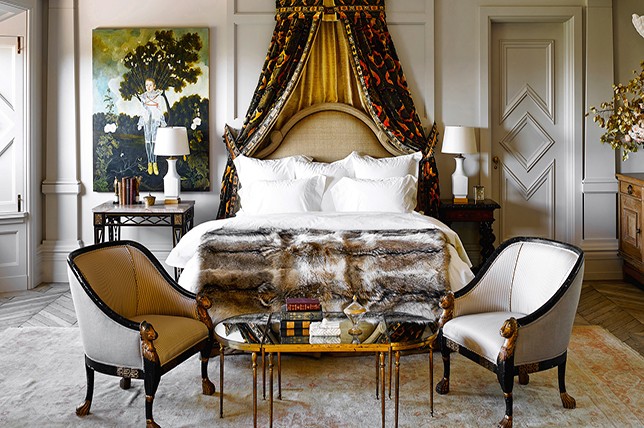
Embodied by a formal spirit, traditional interior design is still a mainstay to this day. Traditional interior design is a broad term that highlighting varied design styles and movement’s that aren’t nailed down to one locked direction or spirit.
Traditional design celebrates the illustrious, rich history of the past by contrasting it with decidedly modern elements for an elegant spin on beautiful design while highlighting 18th and 19th-century European decor. It’s a timeless design style that evokes easy glamor and comfort and is a great direction for those who appreciate antiques, classic art, symmetry, and design rich with history.
Rococo 1700
A hyper elegant and lavishly detailed design style taking cues from botanical silhouettes, Rococo interior design featured unique elements like tortoise shell and pearl embellishments alongside Asian porcelain.
The Industrial Revolution 1760 to 1820
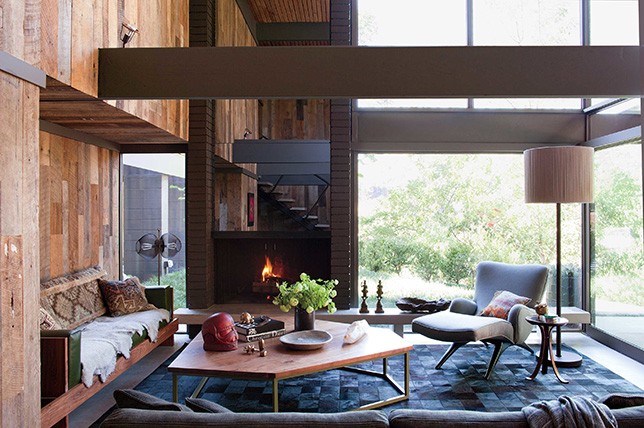
Throughout the Industrial Revolution interior design was available for a wider audience and was easier to access for the general population than ever before. This is in large part due to easier printing processes creating a wide distribution of fashion and lifestyle publications and the fact that luxury items became increasingly attainable.
Neoclassical Style 1780 to 1880
Taking inspiration from ancient Greek and Roman cultures for architectural details and motifs, this era saw furnishings rely heavily on the use of bronze and gold metals, and soft furnishings featuring silk, velvet, and satin. The trend of matching wallpaper and furnishings also took hold.
Tropical 1880’s to Today
As the British empire swept through countries like India and territories like the West Indies, they combined interior design elements from their home country and the regions they were occupying to create a heady mix of the traditional and the extoic.
Aesthetic Movement 1800’s to Today
With ‘art for art’s sake’ in mind, the Aesthetic Movement was a way for radicals to express their dislike of current, tired interior design. The key here was in practicality and function taking importance before beauty.
Tuscan 1840’s to Today
Taking a cue from the charming and calming nature of Tuscany in Italy, the focus of interior design during this period was of straightforward simplicity with hints of luxury for good measure.
Arts & Crafts 1860 to 1910
In order to highlight their opposition to mass-produced ordinary items due to the innovations of the Industrial Revolution, people turned to traditional crafts and classic elements to produce furnishings.
Rustic 1870’s to Today
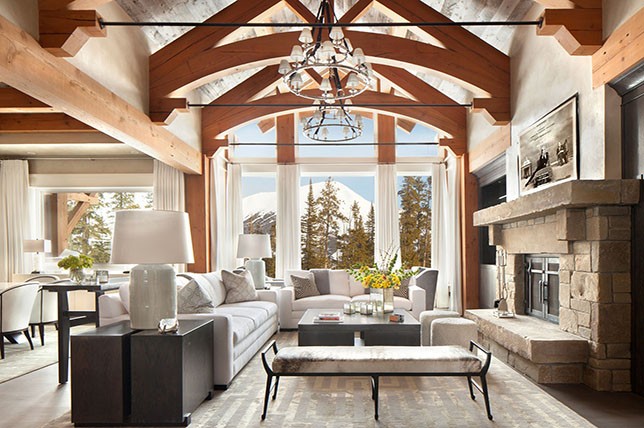
Rustic interior design features handmade furnishings and large, open rooms boasting wooden beams and columns.
Rustic decor provides the perfect combination of comforting, fuss-free design and practical, functional decor, put together to create a warm rustic interior. Natural materials work as the foundation and starting point for creating enviable rustic home decor celebrating the authentic beauty of natural materials to create a cozy, beautiful space.
Modernism 1880 – 1940
The modernist movement stressed simplicity, clarity of form, and rejected noise in design. Some of the movement’s leading figures in include Mies van der Rohe, Le Corbusier, and Eero Saarinen, whose signatures seen in his forever popular Saarinen table and Saarinen chair are the epitome of the design style.
Art Nouveau 1890 to 1920
The enthusiasm behind the Art Nouveau movement was in bringing in natural silhouettes derived by botanical elements that lent the era its signature curved lines and organic shapes.
Colonial Revival 1905 to Today
Popular in the U.S and spurred by the centennial, the Colonial Revival found inspiration from the Neoclassical and Georgian historical styles. By far the most popular style of the time up til WWII, some believe that the launch of the automobile helped to spark people’s interest in historical references as they were able to freely visit documented landmarks.
Eclectic 1900’s to Today
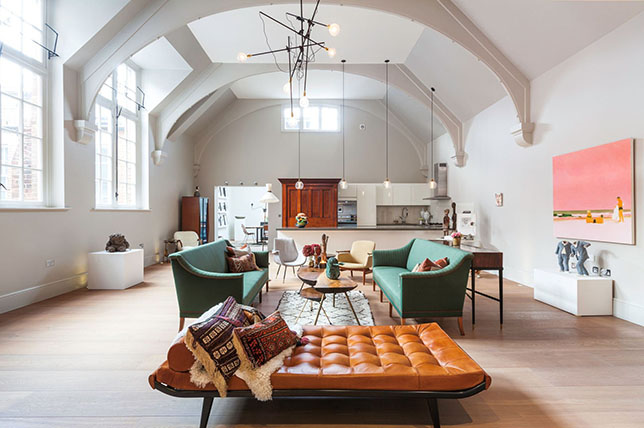
Some historians point to the rise of needing interior designers who understood how to mix different design styles with authority for the sharp increase of designers in the industry as eclectic style took over aesthetic inspiration.
Eclectic style is all about harmony and the coming together of disparate styles, juxtaposing textures, and contrasting colors to create a cohesive, beautifully realized room that wouldn’t be out of place in a home décor magazine as this is one design style that takes verve and a great eye. And since eclectic interior design is all about experimentation and play, do have fun with the freedom it allows.
Modern 1918 to 1950
With a focus on sparse interiors and bold primary colors, Modern interior design eschewed the typically ornate and over decorated design aesthetic trending at the time.
Bauhaus 1920 – 1934
Celebrated to this day for its grand yet minimal and beautifully executed gestures, and founded by German architect Walter Bauhaus, who also created the Bauhaus school of art and design in Weimar Germany, the movement quickly produced some of the most influential architects, sculptors, graphic designers, furniture makers, and design mavericks of the mid to late 20th century.
Country 1920 to 1970
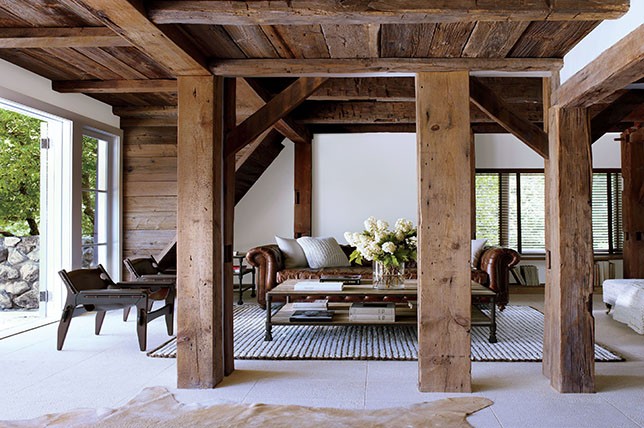
With notes lifted from traditional farmhouse settings, country style was practical but with quality, vintage inspired furnishings.
Today’s take on the modern country style of interior design is an idyllic classic. Stepping away from a purely traditional country design style; modern country allows for more playful and nuanced aspects along with minimal notes.
Art Deco 1920’s to 1960
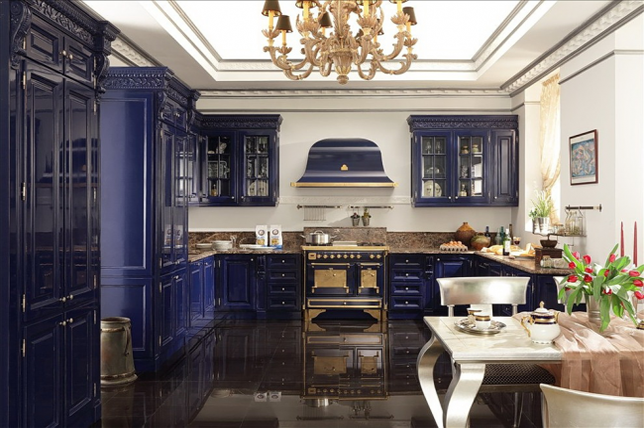
This movement features an intoxicating blend of early 20th century design styles including Constructivism, Cubism, Modernism, Bauhaus, Art Nouveau, and Futurism. One of the most well-known interior design styles, Art Deco represented modernity, everyday glamor, and elegance. The era relied heavily on clean lines, fuss-free angular shapes, bold color, and stylized patterns like zig-zags and optical figures. For added glamor, ornate embellishments and metallic surfaces were also hallmarks of the era.
Materials used in art deco interior design are slick and reflective for everyday glamor in the home. Plenty of metallics are present in this style; from gold to silver, stainless steel, and chrome. They lend any room an elegant and luxurious feel, and they can be used everywhere. Imagine a modern art deco living room with a glass topped gold coffee table, chrome lamps, and a bold geometric patterned rug in black, gold, and white. Glass is also a frequently used material in art deco design; whether that’s through mirrors, glass-topped tables, sculptural elements or an art deco vase or lamp, as glass adds to the elegant feel of an art deco room.
Mediterranean 1920’s to Today
To evoke the feel of coastal European countries, textures from terra cotta, stone, and patterned tiles were heavily featured along with wrought iron, and aquatic hues.
Surrealism 1925 to 1930
Surrealists like famous artists included Salvador Dali, André Breton, and Max Ernst used this avant-garde movement to free people from their associations of what was normal and ultimately predictable in design, music, art, and even interior design.
Mid-Century Modern 1930’s to Today
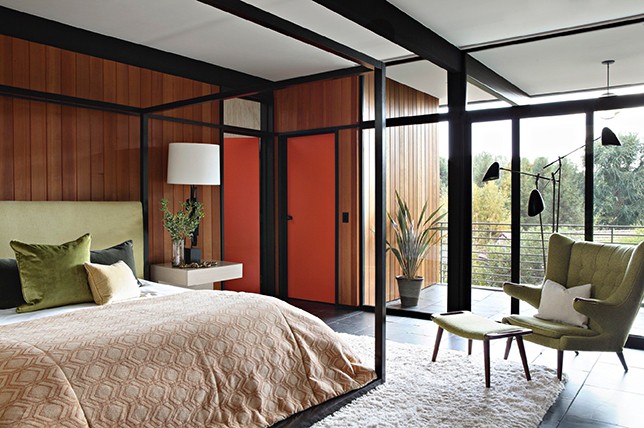
Though the term mid century modern wasn’t coined until the mid-80’s, and though no one really knows it’s true timeline, the era represents a combination of post World War II practicality, 50’s era optimism, 60’s era earthiness, and 70’s era tones and textures neatly wrapped up in a stylish ode to Scandinavian simplicity.
Call it a reaction to the decadence and gilt adorned stuffiness of interior design and architecture through to the 40’s if you will, as at the time of its inception, mid century modern decor was a complete rebuttal and restart for the senses.
The vibe is fresh and poppy, retro-tinged, and completely alluring with its dedication to comfort and practicality wrapped up in beautiful design that never goes out of style. Unlike other aesthetic movements, mid century modern decor is streamlined in design, as form follows function while highlighting the materials used, rather than making them something they aren’t.
Scandinavian Modern 1930’s to Today
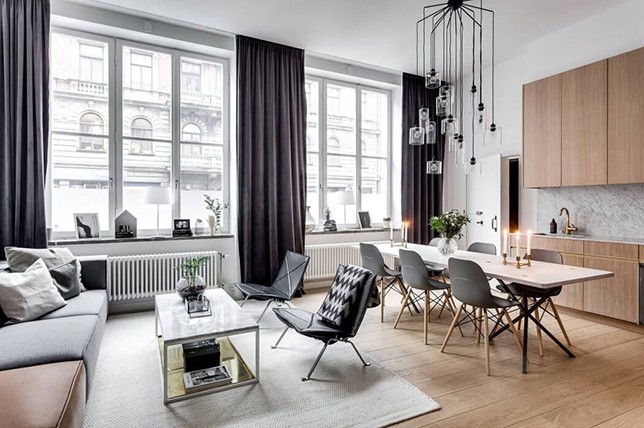
This movement highlights the virtues of beautiful designed, practical objects that are both easily affordable and accessible, which is why the movement remains popular to this day.
Belonging to the school of modernism, Scandinavian interior design is a design movement characterized by a focus on functionalism and simplicity. It also includes the use of natural materials, such as leather, wood, and hemp. Furthermore, a Scandinavian interior design is often influenced by a connection to nature, which combines natural shapes, abstraction, and the use of natural elements.
Transitional 1950’s to Today
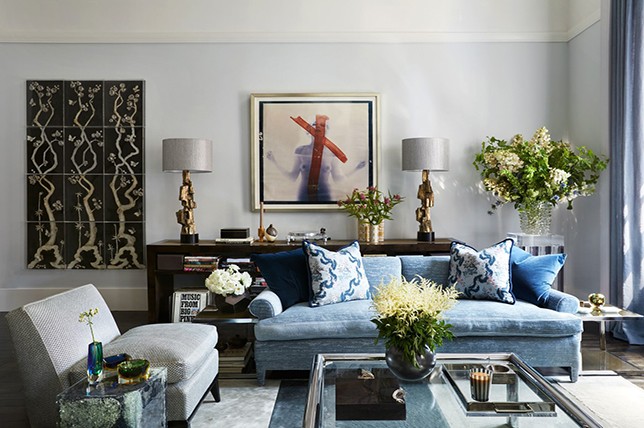
With the invention of the television and its prominence throughout most homes across the U.S, the interior design of sets helped feed the masses appetite for décor more than ever.
Transitional style refers to a mix of traditional and modern furnishings, fabrications, and decorative features that lend you more freedom when looking to decorate your home with ease as there’s no end to the directions you can take the design style. In essence, transitional interior design is the combination of various design styles brought together simultaneously to create a cohesive design in one room.
Postmodernism 1978 – Today
This movement born as a challenge to what people saw to be the generic blandness of the Modernist movement. One of its main figures was Italian architect and designer Ettore Sottsass, with his signature playful shapes, abstract prints, and powerful color stories.
Contemporary 1980’s to Today
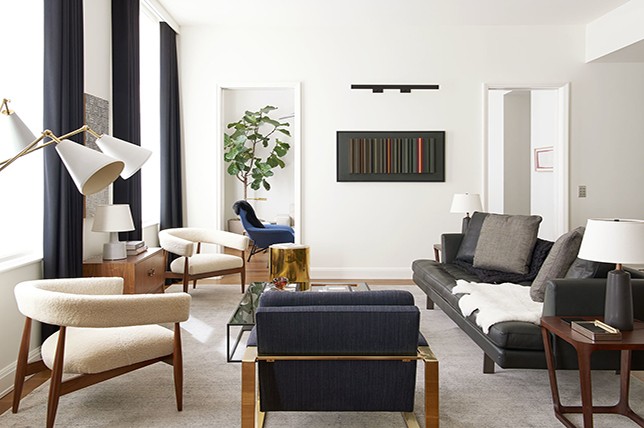
Contemporary interior design is classic yet thoroughly of the moment and timeless thanks to a light-handed, spare take on decorating to ensure it will never feel dated.
While modern decor can feel cold, limiting, and overtly minimal, contemporary style is calming and serene, and is peppered with a focus on architectural elements, decorative details, attention to bold scales, and a concise color palette to create a warm space with easy sophistication.
Simplicity, clean lines, plays on texture, and quiet drama are fundamental in achieving a perfectly balanced contemporary style home.
ELSIE DE WOLFE
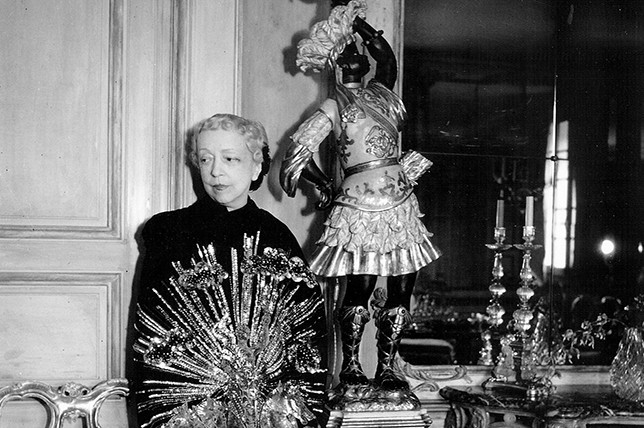
Heralded as “America’s first interior decorator,” Elsie de Wolfe’s life was as opulent as the rooms she decorated, as she’s pictured above in Elsa Schiaparelli’s iconic gilded starburst haute couture coat. The legendary de Wolfe boasts a biography that’s equally wildly romantic and adventurous. After being educated in Scotland and presented at the court of Queen Victoria, she returned to the U.S. and became an actress where she shared a unique “Boston marriage” (a term for two single women living together from Henry James’s The Bostonians) with successful literary agent and lover Elisabeth Marbury.
Her onstage style and costumes—couture garb from Paris—made her an influential tastemaker among spectators in her audience, leading her to become known as the best-dressed woman in the world. Her first foray into interior design was a total eschewing of the dark and brooding Victorian décor in the home she and Marbury shared. After she successfully restyled their residence by decluttering, simplifying, and minimizing its heavily ornamented interior, she became the first interior decorator to be given a design commission.
That commission was to decorate New York City’s first elite social club for women, the famed Colony Club—boasting a slew of notable members with surnames including the likes of Whitney, Morgan, Harriman, and Astor. De Wolfe soon became the most popular interior decorator of her time, and in 1913, she published the first interior design book, “The House in Good Taste.”
She celebrated the unexpected by mixing animal prints with Chinoiserie, had an affinity for Regency and Chippendale styles as well as black-and-white color schemes, and was a pioneer of representing the color beige in décor.
Her most notable projects include the homes of Condé Nast, the Fricks, and the Hewitts. Her anti-Victorian stance and brighter, airier, and less complicated and more minimally minded, refined rooms remains popular to this day.
JEAN-MICHEL FRANK
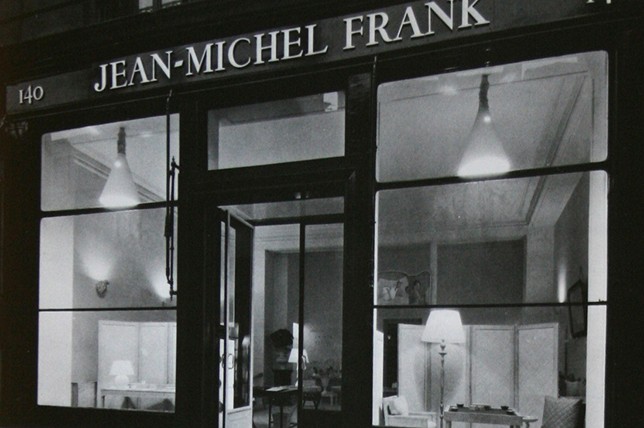
It should come as no surprise that artists routinely find inspiration from the world around them, and it’s easy to imagine the heady effect of 1930’s Paris on the most celebrated decorator and interior designer of the era, Jean-Michel Frank. Lucky for him, his projects were often centered around placing Picassos and Braques throughout the spaces he decorated, and his crew of influential friends included everyone from Left-Bank Parisian artists like Man Ray and socialites such as the Rockefellers.
Considered a minimalist with a rich bent, his layering of divine maximalism makes his work all the more intriguing and inspiring. As a furniture designer, his silhouettes were pared down and subtle and finished with luxurious details. Think intricate mica screens, bronze doors, accessories made of quartz, and the series of shagreen-covered furnishings and sheepskin club chairs he designed for fabled luxury goods maker Hermès. White was a go-to signature shade of his, which he at the same time made look both spare and complex. Frank is also credited with designing one of the most iconic minimalist pieces of furniture in history—the Parsons table—which he would frequently cover with the most luxurious of finishes.
Along with a studied eye for great design and an instinct for the best of quality, Frank took in elements of daily life to make a space feel more approachable, inviting, and realistic. Today his work continues to be celebrated in museums, his furnishings create record-breaking auctions, and you can even buy reproductions of his most iconic pieces designed for Hermès.
SISTER PARISH
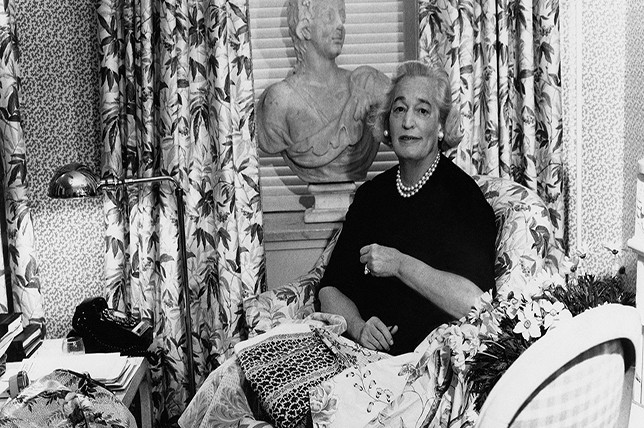
Known for her shrewd take on indulgent taste, Sister Parish is credited with creating the American Country look, one of the most enduring design styles of the last half-century. Born into privilege and pedigree, Parish’s American Country look was realized from her take on English Country, albeit with more warmth, character, and a homespun and charming appeal.
She began her career as an untrained housewife who decorated her home with much fanfare. Having caught the eye of fellow high-society housewives commissioning her to restyle their own homes, Hadley took note of the need for affordable design during the Great Depression and billed herself as a “budget decorator” for those looking to refresh their homes during the challenging economic times of the era.
Her decorative style was a total rejection of her father’s collection of heavy, dark antiques as she leaned more towards feminine ticking stripes, glazed chintz, quilts, hooked rugs, and informal overstuffed armchairs while incorporating elements from the past.
“Innovation is often the ability to reach into the past and bring back what is good, what is beautiful, what is useful, what is lasting.”
Her designs were romantic, warm, and elegant for clients such as Brooke Astor, yet she was known for her caustic, intimidating figure and unforgiving assessments of her client’s spaces.
Parish’s design firm saw many influential designers make a name for themselves beside her including the legendary Albert Hadley, who she worked alongside for some 30-plus years—their professional relationship is often thought to be one of the most successful collaborative partnerships in the world of interiors to this day.
ALBERT HADLEY
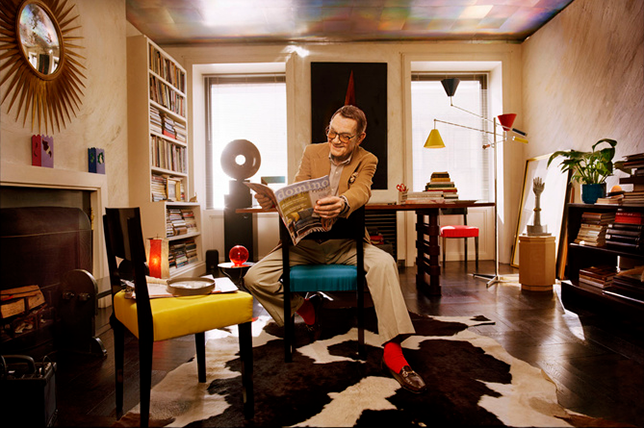
Credited as the father of transitional interior design, celebrated for his masterful pairing of glamor and functionality, and often referred to as the “the dean of American decorators,” Albert Hadley’s project portfolio boasted high society names like Rockefeller, Astor, Getty, and Mellon.
However, for Hadley, high-profile names never took place over brilliant design. “Names really are not the point,” he told New York magazine in 2004. “It’s what you can achieve for the simplest person. Glamour is part of it, but glamour is not the essence. Design is about discipline and reality, not about fantasy beyond reality.”
Born in Tennessee, Hadley moved to New York City after serving in WWII where he studied and taught at Parson’s School of Design and became known for his modern-minded décor style and his instinctual sense of balance and what worked together. He skillfully created heady mixes of design styles with a mantra centered around the idea of “never less, never more.”
Looking for a partner of sorts with more technical talent rather than the instinct that defined her career, Sister Parish brought Hadley on her team in 1962. Parish-Hadley Associates restyled the homes of America’s elite families for decades and is best known for redecorating the living quarters of the Kennedy White House, as well as the Kennedy family’s private homes. After Parish’s passing Hadley continued to work well past his mid-80’s on projects that incorporated an interesting mix of design styles unlike any other designer of his generation.
DOROTHY DRAPER
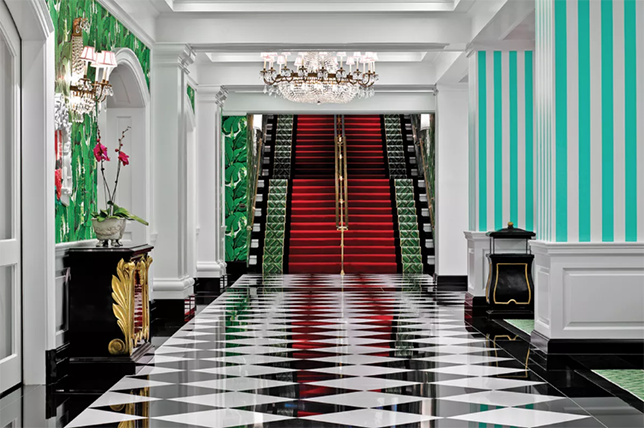
Long heralded as the Coco Chanel of the decorating world, Dorthy Draper’s designs were fearlessly vibrant, sumptuous, joyful, and full of personality. The rooms she designed had either a restrained color palette of classic black and white, while others highlighted oversized graphic patterns and her punchy Technicolor combinations of pinks and greens, turquoise, and citrus hues. A cousin of Sister parish, Draper was the first documented commercial interior decorator, having established the first official interior design firm, Architectural Clearing House, in 1923.
“Almost everyone believes that there is something deep and mysterious about [interior decoration] or that you have to know all sorts of complicated details about periods before you can lift a finger. Well, you don’t. Decorating is just sheer fun: a delight in color, an awareness of balance, a feeling for lighting, a sense of style, a zest for life, and an amused enjoyment of the smart accessories of the moment,” she wrote in her 1939 book Decorating Is Fun!
Named the most influential tastemaker in America in 1960, Draper lent her legendary signature “modern Baroque” style to several iconic buildings including the dining hall at New York’s Metropolitan Museum of Art, the Fairmont and Mark Hopkins hotels in San Francisco, and, most impressively, a complete overhaul of the Greenbrier Hotel in West Virginia – which still looks au currant 70-plus years later.
DAVID HICKS
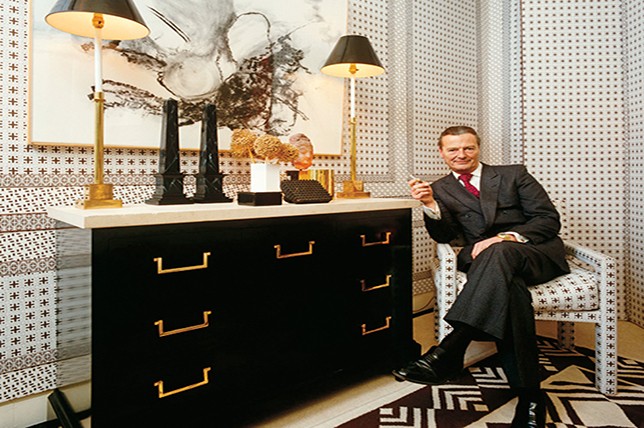
Originally a freelance advertising illustrator in London, David Hicks decorating career took off after a magazine covered the game-changing makeover he did on his parent’s home.
Hicks broke the mold and went against traditionally stuffy and pretentious English decorating practices and went on to become a master of unexpected yet cohesive mixes. His eclectic interiors often featured a distinct juxtaposition of riotous colors, patterns, fabrications, and design styles that were alluring and impressive feats.
A design world darling by the 1960’s, his most notable projects included rooms for Prince Charles and Princess Anne and a sparkling nightclub on an ocean liner and yacht for King Fahd of Saudi Arabia. In the 1970’s, Hicks began producing signature wallpaper, fabrics, and linens for his design boutiques spread across eight countries.
BILLY BALDWIN
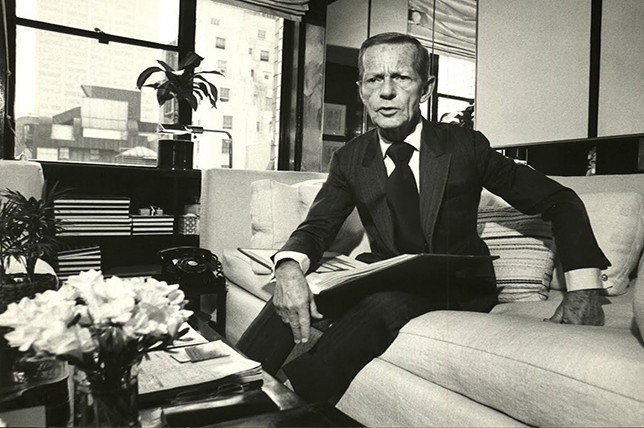
Though he was celebrated for his comprehensive approach to interior design, Billy Baldwin detested the term “interior designer,” opting to be referred to as a “decorator,” his preferred title. He believed a rooms good bones to be a top tenet along with quality and comfort being key.
“I’ve always believed that architecture is more important than decoration. Scale and proportion give everlasting satisfaction that cannot be achieved by only icing the cake,” he famously said.
His interiors were crisp and flawless, and unlike his contemporaries, he worked with client’s existing furnishings and repurposed them with an instinctual drive. From a remarkable refresh of Cole Porter’s Waldorf Towers apartment to Jackie O’s Skorpios compound, to Diana Vreeland’s richly layered red Park Avenue living room, meticulous attention to scale and proportion were a driving force for Baldwin. A master of practical decoration punctuated with bold hues, prints, and well-judged curation, a survey of Baldwin’s work demonstrates how relevant his work remains to this day.

